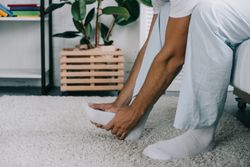
After a diabetes diagnosis, you might be focused on important changes like diet and exercise. While these are essential for managing the condition, there’s another area to consider: foot care. Diabetes can affect how your feet look and feel, and they provide clues about your health status. Here’s what you need to know about this relationship.
How Diabetes Affects the Feet
Nerve Damage
High blood glucose contributes to peripheral neuropathy, or nerve damage that disrupts your ability to feel pain, heat, or cold and leads to tingling or numbness. In some cases, it can also diminish reflexes and lead to poor balance or coordination as the body struggles to send nerve signals to joints like the ankles.
Skin Damage
Diabetes can change the texture of your skin in several ways, including dryness, cracking, and callus growth. In severe cases, people also develop ulcers on the balls of their feet due to nerve damage that prevents them from feeling friction. Constant pressure on the area and other disease complications often make these wounds slow to heal, so they require specialized foot care to prevent infections.
Circulation Problems
 Poor blood flow is also common in people with diabetes. Some of the symptoms are similar to nerve damage, including persistent tingling or numbness. Issues with circulation also impede the skin’s ability to heal. While antibiotics can help, advanced infections require surgical treatment.
Poor blood flow is also common in people with diabetes. Some of the symptoms are similar to nerve damage, including persistent tingling or numbness. Issues with circulation also impede the skin’s ability to heal. While antibiotics can help, advanced infections require surgical treatment.
How You Can Address Foot Care Problems
Inspect Your Feet
Check your feet for changes every morning and evening. Look at the texture of the skin to see if there are any wet areas, blisters, cracks, or open wounds. Cover any injuries with a sterile bandage immediately and check them each day to monitor healing.
Clean & Protect the Skin
Fill a tub with lukewarm water and wash carefully with a mild soap. Clean between your toes to remove any sock lint that might cause friction. Dry your feet and coat them with lotion or balm to prevent dryness and cracking, but skip the areas between your toes—these retain moisture and are vulnerable to infection. Look for foot care products that are marked as noncomedogenic to avoid irritating your delicate skin.
Practice Preventive Care
Minimize the risk of lacerations by trimming your toenails weekly and avoid walking barefoot if you experience neuropathy. Seek professional care if you notice changes to your skin. While calluses and corns can benefit from home treatment, these methods need to be paired with in-office care to avoid diabetes-related complications.
Living with diabetes means keeping a close eye on your health, and the right care provider will make the process easier. Foot & Ankle Specialists of Hamilton County, OH, is a trusted source for foot care throughout the Tri-State area. Their board-certified podiatrists will create an individualized patient care plan that addresses your wellness needs and lifestyle concerns to ensure you stay healthy and active while managing diabetes. Call (513) 769-4408 to make an appointment, and visit the practice online to access new patient documents.
About the Business
Have a question? Ask the experts!
Send your question

